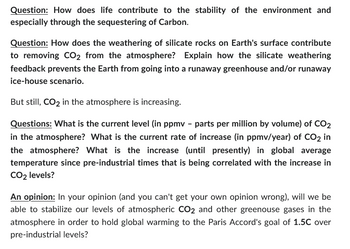
Applications and Investigations in Earth Science (9th Edition)
9th Edition
ISBN: 9780134746241
Author: Edward J. Tarbuck, Frederick K. Lutgens, Dennis G. Tasa
Publisher: PEARSON
expand_more
expand_more
format_list_bulleted
Question
Answer correctly and read the questions corretly, this is all one quesiton if done correclty and organized I will write a very nice review about you! Answer in 20 mintues

Transcribed Image Text:Question: How does life contribute to the stability of the environment and
especially through the sequestering of Carbon.
Question: How does the weathering of silicate rocks on Earth's surface contribute
to removing CO2 from the atmosphere? Explain how the silicate weathering
feedback prevents the Earth from going into a runaway greenhouse and/or runaway
ice-house scenario.
But still, CO2 in the atmosphere is increasing.
Questions: What is the current level (in ppmv - parts per million by volume) of CO2
in the atmosphere? What is the current rate of increase (in ppmv/year) of CO2 in
the atmosphere? What is the increase (until presently) in global average
temperature since pre-industrial times that is being correlated with the increase in
CO₂ levels?
An opinion: In your opinion (and you can't get your own opinion wrong), will we be
able to stabilize our levels of atmospheric CO2 and other greenouse gases in the
atmosphere in order to hold global warming to the Paris Accord's goal of 1.5C over
pre-industrial levels?

Transcribed Image Text:Gaia:
Carbon Regulation
Silicate Weathering
2(CO₂) + 3(H₂O) + CaSiO3 = Ca²++2(HCO3)+H SIO
CO₂
outgassing
Continental
plate
CO₂ and H₂O forms
carbonic acid
Rising
magma Accretionary wedge:.
sediments derived
from land/shelf
Melting of
carbonate rock
Ca²++2(HCO3) CaCO₂ + CO₂ + H₂O
Mid-ocean ridge
Shelf: major area of
limestone deposition
Carbonate compensation depth
Trench
Oceanic plate (basalt)
Some carbonate rocks
are preserved by overlying
sediments and subducted
sks.to
Carbon-silicate
cycle.
We now are beginning to recognize the Earth System comprising the physical and
geological materials of the Earth and its place in the Solar System as well as the
biology of planet, all working together produces a nearly stable environment and
condition. In 1972, James Lovelock proposed the Gaia hypothesis which argued that
life and biology are importantly involved in regulating the planet's surface
environment through a stable Carbon Cycle.
Expert Solution
This question has been solved!
Explore an expertly crafted, step-by-step solution for a thorough understanding of key concepts.
This is a popular solution
Trending nowThis is a popular solution!
Step by stepSolved in 3 steps

Knowledge Booster
Recommended textbooks for you
 Applications and Investigations in Earth Science ...Earth ScienceISBN:9780134746241Author:Edward J. Tarbuck, Frederick K. Lutgens, Dennis G. TasaPublisher:PEARSON
Applications and Investigations in Earth Science ...Earth ScienceISBN:9780134746241Author:Edward J. Tarbuck, Frederick K. Lutgens, Dennis G. TasaPublisher:PEARSON Exercises for Weather & Climate (9th Edition)Earth ScienceISBN:9780134041360Author:Greg CarbonePublisher:PEARSON
Exercises for Weather & Climate (9th Edition)Earth ScienceISBN:9780134041360Author:Greg CarbonePublisher:PEARSON Environmental ScienceEarth ScienceISBN:9781260153125Author:William P Cunningham Prof., Mary Ann Cunningham ProfessorPublisher:McGraw-Hill Education
Environmental ScienceEarth ScienceISBN:9781260153125Author:William P Cunningham Prof., Mary Ann Cunningham ProfessorPublisher:McGraw-Hill Education Earth Science (15th Edition)Earth ScienceISBN:9780134543536Author:Edward J. Tarbuck, Frederick K. Lutgens, Dennis G. TasaPublisher:PEARSON
Earth Science (15th Edition)Earth ScienceISBN:9780134543536Author:Edward J. Tarbuck, Frederick K. Lutgens, Dennis G. TasaPublisher:PEARSON Environmental Science (MindTap Course List)Earth ScienceISBN:9781337569613Author:G. Tyler Miller, Scott SpoolmanPublisher:Cengage Learning
Environmental Science (MindTap Course List)Earth ScienceISBN:9781337569613Author:G. Tyler Miller, Scott SpoolmanPublisher:Cengage Learning Physical GeologyEarth ScienceISBN:9781259916823Author:Plummer, Charles C., CARLSON, Diane H., Hammersley, LisaPublisher:Mcgraw-hill Education,
Physical GeologyEarth ScienceISBN:9781259916823Author:Plummer, Charles C., CARLSON, Diane H., Hammersley, LisaPublisher:Mcgraw-hill Education,

Applications and Investigations in Earth Science ...
Earth Science
ISBN:9780134746241
Author:Edward J. Tarbuck, Frederick K. Lutgens, Dennis G. Tasa
Publisher:PEARSON

Exercises for Weather & Climate (9th Edition)
Earth Science
ISBN:9780134041360
Author:Greg Carbone
Publisher:PEARSON

Environmental Science
Earth Science
ISBN:9781260153125
Author:William P Cunningham Prof., Mary Ann Cunningham Professor
Publisher:McGraw-Hill Education

Earth Science (15th Edition)
Earth Science
ISBN:9780134543536
Author:Edward J. Tarbuck, Frederick K. Lutgens, Dennis G. Tasa
Publisher:PEARSON

Environmental Science (MindTap Course List)
Earth Science
ISBN:9781337569613
Author:G. Tyler Miller, Scott Spoolman
Publisher:Cengage Learning

Physical Geology
Earth Science
ISBN:9781259916823
Author:Plummer, Charles C., CARLSON, Diane H., Hammersley, Lisa
Publisher:Mcgraw-hill Education,